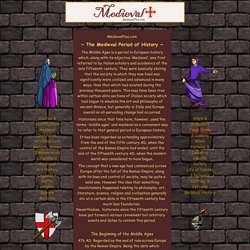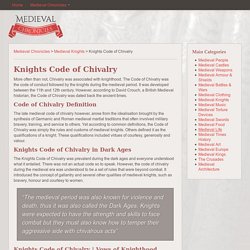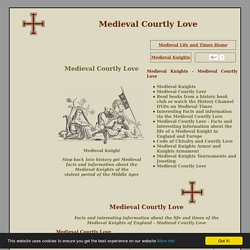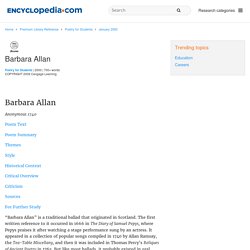

Knights Code of Chivalry. Knights Code of Chivalry A knight was expected to have not only the strength and skills to face combat in the violent Middle Ages but was also expected to temper this aggressive side of a knight with a chivalrous side to his nature.

Medieval History, Castles. MedievalPlus.com The Middle Ages is a period in European history which, along with its adjective ‘Medieval’, was first referred to by italian scholars and academics of the late fifteenth century.

They were basically stating that the society in which they now lived was significantly more civilized and advanced in many ways, than that which had existed during the previous thousand years. This may have been true within certain elite sections of Italian society which had begun to emulate the art and philosophy of ancient Greece, but generally in Italy and Europe overall no all-pervading change had occurred. Historians since that time have, however, used the terms 'middle ages' and medieval as a convenient way to refer to that general period in European history.
Code of Chivalry. More often than not, Chivalry was associated with knighthood.

Medieval Courtly Love. Facts and interesting information about the life and times of theMedieval Knights of England - Medieval Courtly Love Medieval Courtly LoveThe romance of Medieval Courtly Love practised during the Medieval times of the Middle Ages was combined with the Code of Chivalry and the art of Chivalry.

There were strict rules of courtly love and the art of Medieval Courtly Love was practised by the members of the courts across Europe during the Medieval times and era. The romance, rules and art of Medieval Courtly Love allowed knights and ladies to show their admiration regardless of their marital state. It was a common occurrence for a married lady to give a token to a knight of her choice to be worn during a Medieval tournament. There were rules which governed Medieval Courtly Love but sometimes the parties, who started their relationship with such elements of Medieval Courtly Love, would become deeply involved.
Unknown – The Twa Corbies. Famous Poems Analysis (Pt. 3) Oh, in the merry month of May, When all things were a-blooming, Sweet William came from the Western states And courted Barbara Allan.

But he took sick, and very sick And he sent for Barbara Allan, And all she said when she got there, “Young man, you are a-dying.” “Oh yes, I’m sick, and I’m very sick, And I think that death’s upon me; But one sweet kiss from Barbara’s lips Will save me from my dying.” “But don’t you remember the other day You were down in town a-drinking? You drank your health to the ladies all around, And slighted Barbara Allan.” Oh yes, I remember the other day I was down in town a-drinking; I drank my health to the ladies all ’round, But my love to Barbara Allan.” He turned his face to the wall; She turned her back upon him; The very last word she heard him say, “Hardhearted Barbara Allan.” And every bell, it seemed to say, As she passed on through London Town, She heard some bells a-ringing, “Hardhearted Barbara Allan.” Analysis of Barbara Allan by Riley Fillius on Prezi. Dictionary of the Scots Language. Ebola And The Black Death May Be Terrifyingly Similar, Science Says.
History does not paint the Middle Ages as a fun time.

Between 1347 and 1352, a vicious plague known as the Black Death ravaged Europe, killing an estimated 20 million to 25 million people — almost a third of the population at the time. History classes have long taught that the Black Death was synonymous with the bubonic plague, a bacterial disease spread by fleas on rodents, but in the wake of the current Ebola outbreak in West Africa, researchers are discovering that the Black Death could have been an Ebolalike virus. I didn't think the Ebola situation could get any scarier, but it just did. In their new book Biology of Plagues: Evidence from Historical Populations, researchers Christopher Duncan and Susan Scott make the argument that the Black Death was most likely caused by a hemorrhagic virus like Ebola, rather than the bacteria related to the bubonic plague. The duo looked at everything from symptoms to the way the two diseases spread. Horrific Symptoms How They're Spread Shudder. Was Ebola Behind the Black Death?
Controversial new research suggests that contrary to the history books, the "Black Death" that devastated medieval Europe was not the bubonic plague, but rather an Ebola-like virus.

History books have long taught the Black Death, which wiped out a quarter of Europe's population in the Middle Ages, was caused by bubonic plague, spread by infected fleas that lived on black rats. But new research in England suggests the killer was actually an Ebola-like virus transmitted directly from person to person. The Black Death killed some 25 million Europeans in a devastating outbreak between 1347 and 1352, and then reappeared periodically for more than 300 years.
Scholars had thought flea-infested rats living on ships brought the disease from China to Italy and then the rest of the continent. Barbara Allan - Poetry for Students. Anonymous 1740 Poem Text Poem Summary Themes Style Historical Context Critical Overview Criticism Sources For Further Study “Barbara Allan” is a traditional ballad that originated in Scotland.

As are all traditional ballads, “Barbara Allan” is a narrative song, or a song that tells a story. Poem Text.